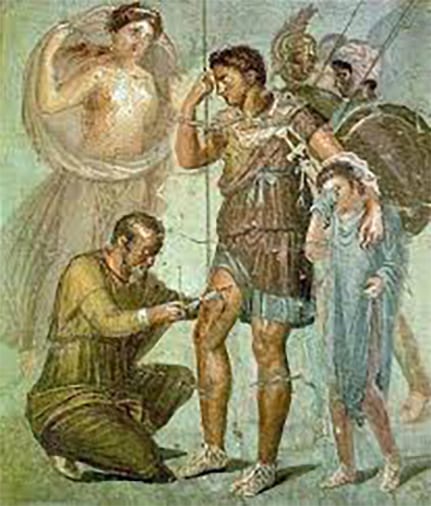References to Aeneas and to all the events linked to the Virgilian narrative could not be missing from the Naples National Archaeological Museum. With its numerous collections supplied by the urban centers buried by Mount Vesuvius’ eruptions, MANN (Short for Museo Archeologico Nazionale di Napoli) offers, moreover, a conspicuous and irreplaceable glimpse into ancient Pompeian wall-painting and statue-making practices.
Beyond the uncountable herms and votive statuettes dedicated to Venus, mother to the Trojan hero, its imposing marble sculptures are also noteworthy. These are represented in an interesting typological variety: from the Aphrodite Frejus in roman replicas of the original greek versions from the IV and V B.C. from the Pompeii and Santa Maria Capua Vetere areas, to the Sosandra found in Baia, to another subject found in Castellamare di Stabia, to Pompeii’s Modest Aphrodites, Hercolaneum, Sinuessa, to the Pompeian statue replica of a greek original of hellenistic age.
However, the aeneadic path is profoundly significant and suggestive especially in relation to the frescoes. The most relevant document is the Injured Aeneas, found in the triclinium of Publius Vedius Siricus’s house in Pompeii – recently restored under the “Grande Progetto Pompei” initiative – that hosts various plaster casts of victims of the infamous eruption. In a large exedra room, triclinium beds were placed around a marble-slabbed floor, to which refined frescoes inspired by the Trojan cycle operated as counterpoints. The scene that depicts Aeneas leaning on the adolescent Ascanium, crying, and wiping his tears away with a cloth, all while Iapix pulls an arrow out from the wounded Trojan, under the vigilant eye of his mother Venus that delicately holds a veil, through which one can see her coronet.
Another painting linked to the Virgilian narrative is the one found in the atrium of Meleagro’s residence, in Pompeii, the Abandoned Dido. The Queen of Carthage, surrounded by two acolytes, cries while sitting on the throne for Aeneas’ departure. The ship sailing away from Africa, is embodied by a woman, placed on the right of the painting wearing elephant spoils on her head.
Two paintings picture the Trojan Horse entry into the city. In both a jubilant trojan crowd is shown favoring the entrance of the fatal strategic machine, while a lonesome Cassandra, standing aloof, remarks her silent dissent.
Another painting is linked to the Palladium events. The Pompeian fresco refers, in fact, to the theft of Pallade’s statue from Troy. Ulysses wearing a pileus holds the stolen statues with the help of Diomedes, despite Cassandra’s opposition. Aeneas is not present in the scene, even though in a variation of the myth, he receives the precious simulacrum in Campania, before bringing it to Lazio, to protect the future city of Rome.
Maria Teresa Moccia Di Fraia

